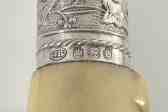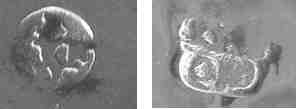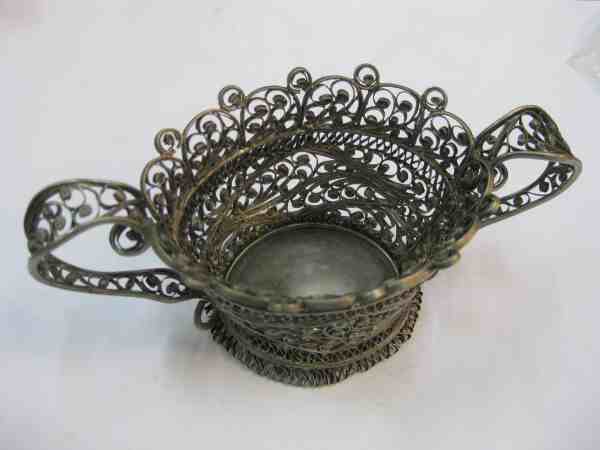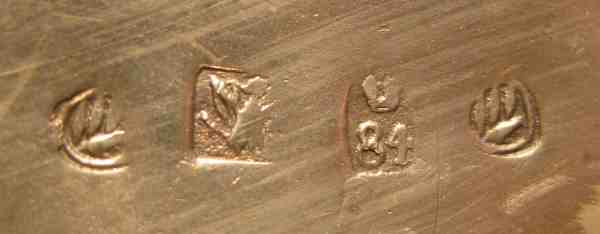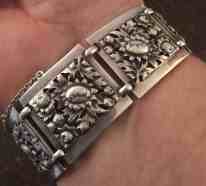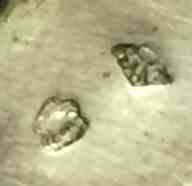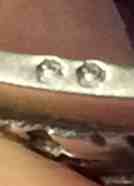YOUR GUIDE TO FEBRUARY NEWSLETTER:
articles
new members
members' window
mail to ASCAS
replies to questions
a page per month
a silversmith per month
a word per month
a book on my shelf
a crest per month
contributors to this Newsletter
search engine
disclaimer and privacy policy
A new article for
ASCAS website
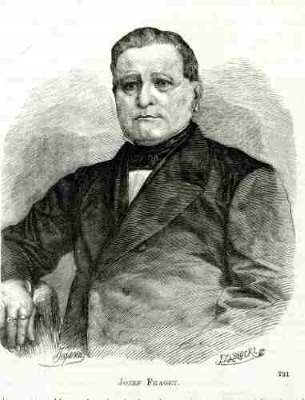
Joanna Paprocka-Gajek and David N. Nikogosyan present:
Warsaw Silver Plate Companies: I. Joseph Fraget

Nearly 200 years ago two French jewellers, the brothers Alphonse and Joseph
Fraget, arrived in Warsaw to start the production of relatively cheap silver table
ware. At that time Warsaw was the capital of the newly-established Kingdom of
Poland (by Vienna Congress in 1815), which was a kind of pseudo-autonomous state
inside the Russian Empire and was ruled by the tsar Alexander I. Warsaw
authorities, trying to revive the local economy after the Napoleonic wars, were
very interested in foreign investment, especially in that connected with novel
technologies. Indeed, the silver items produced by brothers Fraget looked like
silver items but in reality were made of copper covered by a thin silver layer. The
innovative method of silver deposition was developed in France towards the end of
the XVIIIth century, however, it was still a newcomer in this part of Europe in the
beginning of the XIXth century. This new French technology involved soldering of a
thin silver sheet to the red-heated copper plate with subsequent rolling (so-called, "rolled silver" plating techniques). Such copper base with a fused silver layer was
called "SILVER PLATE" or simply "PLATE" ("PLAQUÉ" in French,
"PLATER" in Polish)...
click
here

New members
Welcome to new ASCAS members:
Pamela Aitken - USA
Kathy Burbank - Canada
Marina Dalla Vedova - Italy
Malcolm Underwood - England UK
Members' Window # 109
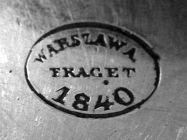
David N. Nikogosyan and Joanna Paprocka-Gajek present:
Marks used by Joseph Fraget company on silver-plated hollow ware

The Joseph Fraget silver plate company created a rather sophisticated system of hollow ware marks. Interestingly, there was no indication
of the amount of silver used for plating (except in the early period 1824-1840). Instead, the applied technology of silver deposition (fusion-based or galvanic) was clearly mentioned.
This list of marks is the most comprehensive one, available in literature. For the first time, it includes the hollowware marks of independent Poland. However, it doesn't
contain either cutlery marks or so-called small marks, used in the case of the shortage of space for marking, i.e., when marking the bottom rim of a tea glass holder......
click here

|
Mail to ASCAS:
e-mail
silverassociation@yahoo.it
Giovanni Ciceri writes:
... I need your assistance to identify these marks.
I believe they are German (Berlin) but I have no idea about age and maker.
Any help will be greatly appreciated.
Giovanni Ciceri
Robin Gibson writes:
... I collected an attractive pair of ladles, James Dixon marks. The marks might be unusual, and could indicate an approximate date. The first mark has a 'crown' plus A1, and I had read on your
website that the use of the 'crown' was discontinued at a certain date. I couldn't find identical marks on your pages.
Any comment would be much appreciated
Robin Gibson
The trumpet (bugle) was used from 1879/1881 (but an example was found on a spoon c. 1835). The Crown was forbidden in 1895 c.
Your ladles were manufactured in the period 1879-1895 c.
Below you can see an example of how silverplate marking was changed when the use of the "crown" was forbidden:
Giorgio Busetto
Robert Bonadeo writes:
... I submit to your attention a Russian tea cup holder and hallmarks for possible identification.
The mark is interesting in that the maker uses the same mark for the first and last character in the mark, but they seem to be different stamps with the same mark.
Maybe he has the same name as the city he lived in, or the assayer was the silversmith? The 84 mark is clear, but I haven't been able to find what era it was from.
The other character is also a mystery since there is noticeable wear and the stamp wasn't deep or clear.
Robert Bonadeo
Your item isn't Russian but imported to Russia from abroad. The mark isn't well readable but the '84' looks as a Kokoshnik import mark used c.1908/1926,
see my website at http://www.silvercollection.it/dictionarykokoshnik.html
Any suggestion about the origin of the basket would be welcome
Giorgio Busetto
Helen Godden writes:
... thank you for your website and so much information. I was so excited today to pick up a bracelet from Trash and Treasure market and from my research it is French (crab)
with the maker's diamond with HF and a hammer. As best as I can work out Henri Fougery 1897 but your site is the only site to mention him.
I have found no other info on the web. Can you direct me or give me any info please.
Helen Godden
I updated the information about the maker: Address: 61 rue Notre-Dame-de-Nazareth (1897) and 52 rue Meslay (1908).
See my website at http://www.silvercollection.it/frenchsilversmithsH.html
Giorgio Busetto
Bob Pino writes:
...I was searching for various silver manufacturers from my mother's home town, Kokkola, Finland and came across a query in your newsletter from a Derek Jones
(see newsGIUG97.html) regarding the makers mark on his father's Puukko (hunting knife).
Should you be able to contact him, I believe that he would be interested in the following information.
While the silver maker's mark is Kantola of Kokkola, the Kauhava style puukko with its stacked birch bark handle and Finnish Lion decal was made by Iisakki Jarvenpaa.
While difficult to read, the signature of Iisakki Jarvenpaa is engraved on the blade in the blood groove.
Kauhava is a town and municipality of Finland. It is located in the province of Western Finland and is part of the Southern Ostrobothnia region, 400 kilometres (250 mi)
northwest of Helsinki.
Kauhava puukko's are sometimes referred to as being in the Ostrobothnian (historical province of the kingdom of Sweden before 1809) style. At one time, as many as five different
knife-making enterprises were underway in the town, but today there is only one – Iisakki Järvenpää Oy, which has been making knives in Kauhava since 1879.
Mr. Jones puukko was obviously a very special presentation piece. The only one that I have seen as heavily embellished as his is of modern origin.
My puukko, presented to me by a late aunt and uncle in 1953, is identical to the one pictured below although in much better condition. My sheath is, however, different from both
that pictured or the beautiful one that accompanies Mr. Jones knife.
For information, the puukko below was sold for $115.00 in 2014 by Kellam Knives Worldwide, Inc.of Lantana, FL.
Best regards,
Bob Pino
David Mckinley writes:
Here is a possible answer to David Boddy's query.
It appears to be a reproduction of a late 17th century item of small work which obviously proved unsatisfactory as it didn't last long in production.
We are not sure exactly how it was originally intended to be used and I can offer no idea as to the purpose of this modern piece I am afraid.
David Mckinley
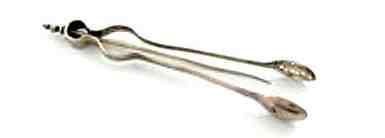
|
Possible combination tea strainer spoon and andiron tea tongs by Peter Harache II London c1698
(Courtesy Woolley & Wallis-Auctioneers of Salisbury)
|
Clive Taylor writes
This appears to be the top half of a pair of Andiron sugar tongs. These were made in the early 1700's and this appears to be broken example of a much later copy of one. Originally the detachable
probe shaft was supposedly intended to clear the spout of the owner's teapot of leaves!
The arms have probably been broken at some stage and for totally unfathomable reasons the break has been smoother off and made decorative.
Why a 1700 style pair of tongs would have been copied in 1939 and why altered to its present configuration is even more of a mystery.
Or I may be totally wrong!
Clive Taylor
Carole Thomas writes
David Boddy asked to identify an item in your last newsletter. It is a lemon squeezer. You take a slice of lemon and impale it on the point with the edges touching the sides. When you squeeze the
sides together, you get lemon juice plus seeds unless you remove them first.
A slice is easier than a half a lemon but it works if you squeeze as lot harder. I give them to guests when I serve fish
but put the lemon slice on before as guests have been puzzled when I just put them by the plate. Interesting conversation however.
Carole Thomas
Also Charles C. Cage, Andrea Menarini and Claudio Morelli
have identified the mysterious object as a lemon squeezer.
I believe this is the right answer to David Boddy's puzzle
Giorgio Busetto
"A PAGE per MONTH"
In this column we presents a page obtained from makers'
brochures, books, auction catalogs, advertising or whatever
other printed paper, related to silver, that may be of interest
for ASCAS members.
The images will be published at a "low resolution" level and for
private and personal use only.
This column is published under the kind permission of Giorgio
Busetto's website

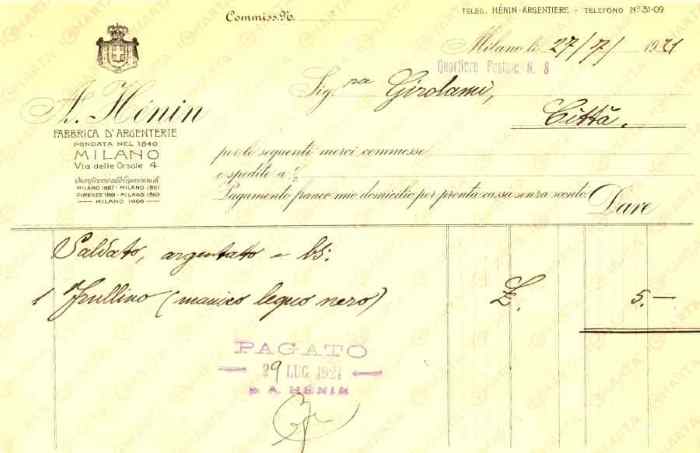 |
This month ASCAS presents a 1921 invoice of:
A.HENIN
FABBRICA D'ARGENTERIE
Via delle Orsole 4 Milano
The firm was founded in Milan (Italy) by Luigi Henin in 1848 succeeding to Henin & Carlier.
The workshop was active under the sign of the "crossed flatware".
In 1868 Anatolio Henin (born 1831) succeeded to his father, moving the business to Via Soncino Merati 13 (1869-1873) and to Via delle Orsole 4 (1874).
In 1935 the firm registered the mark "42 MI", changing its style in 1970 to A. Henin snc (Piazza Borromeo 10, Milano).
The firm went out of business in the 1980s.
ADVERTISEMENTS IN SILVER - SILVER ADVERTISING
section of www.silvercollection.it website
|
"A WORD per MONTH"
In this column we
present an abstract from a page of the "What is? Silver
Dictionary"
courtesy of


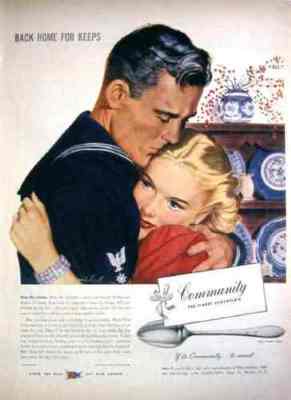
|
ONEIDA COMMUNITY IN WWII
THE ADVERTISING CAMPAIGN
"BACK HOME FOR KEEPS"
In 1942 Oneida Ltd ceased silverware manufacture turning its workforce and plants to more essential war production.
To maintain alive in the public the company's brand name, Oneida applied to the advertising firm of BBDO (Batten, Barton, Durstine, & Osborn).
BBDO conceived for Oneida an advertising campaign called, "Back Home For Keeps" that combined the company's image to a patriotic message.
The first ad of the series appeared in LIFE Magazine, September 13, 1943. As well as in the LIFE Magazine, the advertisements were published also in high-diffusion women's magazines as Cosmopolitan,
The Ladies Home Journal and Good House Keeping.
The illustrator responsible of the campaign was Jon Whitcomb (1906-1988), but, after his enlisting in the Navy, most of the illustrations were painted, in Whitcomb's style, by an unidentified
artist signing himself, "Michael"....
more
|
"A SILVERSMITH per MONTH"
|
|
HOLLAND, ALDWINCKLE & SLATER
The firm was established in 1838 when Henry Holland (sr, born 1806) entered his first mark in London Goldsmiths' Hall.
Henry Holland entered in partnership with Thomas Frercks trading as Holland & Frercks at 13 Lower Smiths Street, Clerkenwell.
Thomas Frercks retired in 1841 and Henry Holland (sr) continued the business on his own account.
His elder son Henry Holland (jr. born 1830) obtained his freedom of the Goldsmiths' Company in 1851 and entered in the business with his father changing the firm's name to Henry Holland & Son.
In 1866 Henry Holland & Son bought the firm of Elizabeth Eaton & Son moving its premises to 16 Jewin Crescent, Aldersgate Street.....
more
|
"A CREST per MONTH"
DEEDES
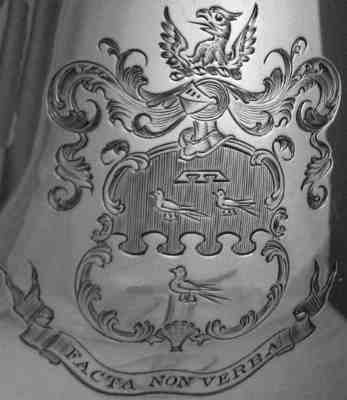
|
An eagle's head erased
The crest of William Deedes, esq. of Sandling Park, Kent
The Latin motto "Facta Non Verba" (Deeds, not words)
The crest was found on a silver coffee pot hallmarked London 1927, maker Sebastian Henry Garrard of Garrard & Co Ltd

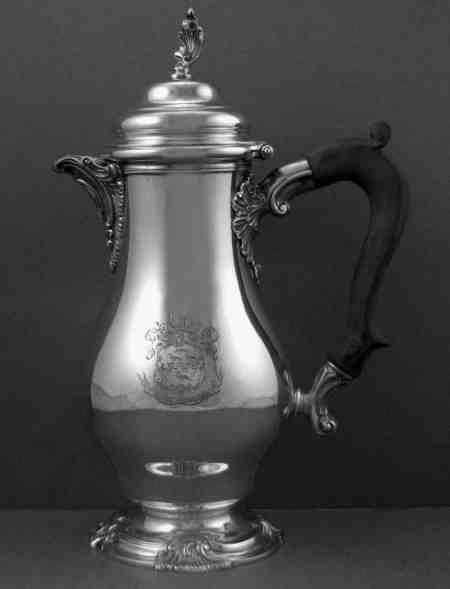
|
Closing our FEBRUARY 2016 edition of ASCAS Newsletter I hope
you have appreciated its content.
Your comments, suggestions and advice will be of great help.
My thanks to Robert Bonadeo, Charles C. Cage, Giovanni Ciceri, Robin Gibson, Helen Godden, David Mckinley, Andrea Menarini, Claudio Morelli,
David N. Nikogosyan, Joanna Paprocka-Gajek, Bob Pino, Clive Taylor and Carole Thomas for their precious contributions.
Giorgio Busetto
Secretary
DISCLAIMER AND PRIVACY POLICY
ASCAS is a community of people having a common
interest in antique silver.
It is a non-profit association without commercial links.
Membership is open to whomever has a true interest in
this subject matter.
ASCAS has no real property and no fees are requested nor
accepted from members.
ASCAS keeps in touch with its members only through
periodical newsletters, e-mails and web-site updating
and ignores and is not responsible for any other
activity pursued by its members.
Likewise, ASCAS is not responsible for opinions,
evaluation and images displayed, and in any form
published or supplied for publication, by its members
who, in any case, maintain the property of their works
and assure the respect of national and international
legislation about Intellectual Property.
ASCAS does not have the full addresses of its members (only
town, country and e-mail address are requested for
membership).
ASCAS handles and protects with care its members' e-mail
addresses, will not disclose the addresses to third
parties, will use this information only to reply to
requests received from members and for communications
strictly related to its activity.
These rules are expressly accepted by submitting the
membership request.
|
|
 newsletter
# 141 February 2016
newsletter
# 141 February 2016



